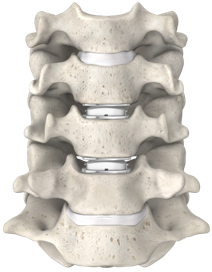Your doctor will perform a physical examination, checking for range of motion and strength in your neck and arms. Your doctor will also order images of your neck: x-ray, MRI, or CT scan. In the images, your doctor will look for thinning discs, unhealthy bone growth, and pinching of the nerve roots and spinal cord.
Conservative treatment is usually the first choice in the care of degenerative disc disease. Your doctor may suggest physical therapy, rest, anti-inflammatory medications, exercise, heat, and lifestyle changes. If conservative care does not help, if a nerve is pinched (compressed), or if the pain is severe, your doctor may recommend surgery.
Discuss treatment options with your doctor. Need help finding a doctor? Visit the surgeon locator.
Disc Herniation Diagnosis & Treatment
Using the type and location of pain as a reference, your doctor will perform a physical examination. The exam checks for the range of motion and strength in your neck and arms. Your doctor will also order images of your neck: x-ray, MRI, or CT scan. An MRI will show the location of the herniated disc and any pinched nerves.
Unless a nerve is severely pinched, conservative treatment can be the first choice in the care of disc herniation. Your doctor may suggest physical therapy, rest, anti-inflammatory medications, and lifestyle changes. If conservative care does not help, if a nerve is pinched, or if pain is severe, your doctor may recommend surgery. Some patients have worsening weakness in the arms, where having surgery sooner can be beneficial. In some cases, if there is no surgical intervention, permanent nerve damage can occur.
Discuss treatment options with your doctor. Need help finding a doctor? Visit the surgeon locator.
Mobi-C Cervical Disc Replacement and Cervical Fusion Treatment Options – How do they compare?
Before artificial discs were approved for use, most often a patient would get an anterior cervical discectomy and fusion (ACDF). In this fusion surgery, the surgeon removes the unhealthy disc. The empty disc space is filled with a bone spacer or plastic implant. The implant helps match the disc height to the levels above and below. Restoring the disc height can help remove pressure on the nerves and/or spinal cord. Then, a metal plate with screws is placed on the front of the neck. The plate helps keep the spacer in place and stop movement at the level or levels it spans. This helps new bone grow between the vertebrae (fusion).

However, studies have shown cervical disc replacement to have benefits over fusion.1,2
In a surgery with the Mobi-C Cervical Disc, the unhealthy disc is removed, but instead of a bone spacer or plastic implant along with a plate and screws, a Mobi-C is implanted into the disc space. Where a fusion procedure is intended to eliminate motion at the surgery levels, the goal of a surgery with Mobi-C is to allow motion at those levels.

2-Level Mobi-C Cervical Disc Replacement
Why get a cervical disc replacement over a fusion?
Both a fusion and Mobi-C artificial disc surgery:
- Replace the damaged disc.
- Try to match a heathy disc height and alleviate any pressure on the nerves.
Unlike fusion the Mobi-C implant is:
- Designed to maintain neck movement and adapt to the motion in your spine.
Maintaining neck motion can result in reduced adjacent level disease and reduced reoperation rates.